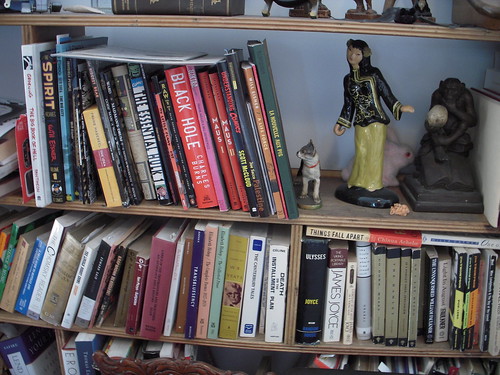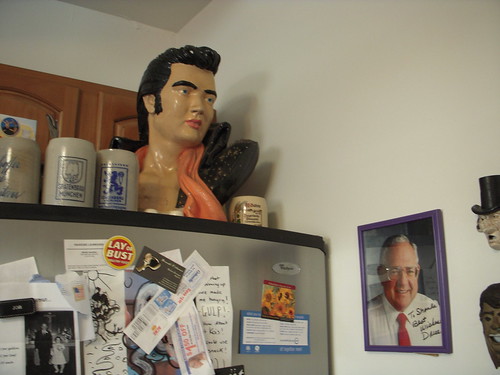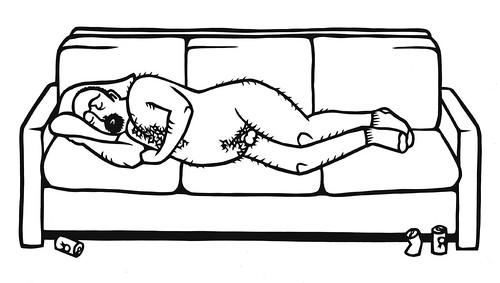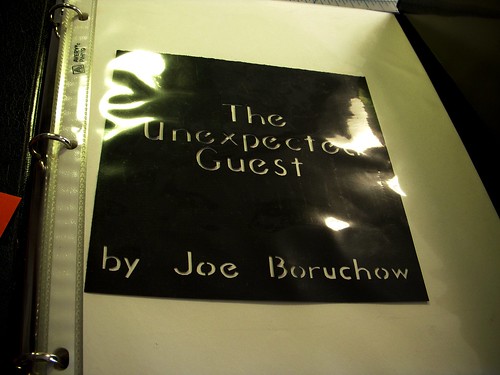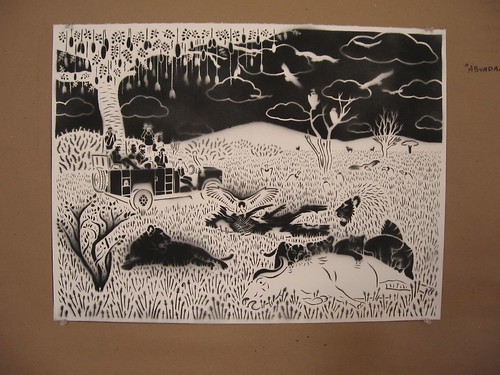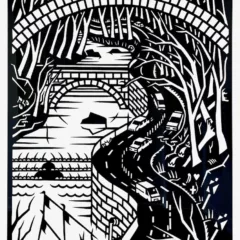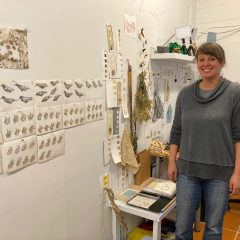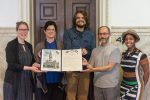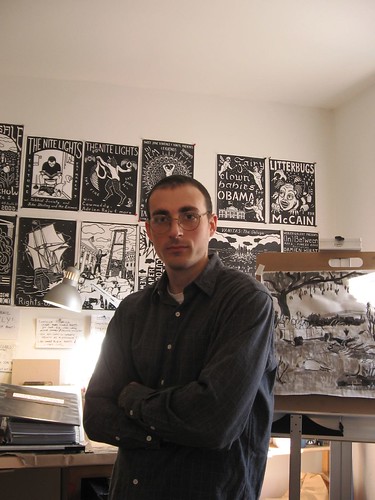
Joe Boruchow, in his studio, with his graphic novel in a binder on the desk and a study for Abundance on the easel.
Cut paper artist Joe Boruchow‘s solo show at Bean Cafe (it closes today), is the second show of his we’ve seen there. Bean loves Joe and Joe loves Bean and he’s shown there a bunch of times since 2002.
Boruchow’s narrative cut-outs are great, and he seems to march to his own drummer. We wanted to meet him and hear more about his art and him, so we paid him a visit.
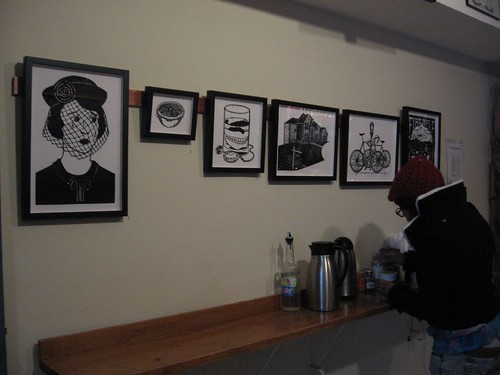
Installation detail of Fire Sale, Joe Boruchow’s most recent exhibit at the Bean Cafe.
In Philly there are several cut paper artists (Hunter Stabler, Natasha Bowdoin among others) and we just saw a show of cut paper by Robert Cumming at Janet Borden in New York (see post). We think that Boruchow is among the best working the medium –his content is edgy and his technique is pristine. Like everyone we know who works in paper, Boruchow applied for the Pew this year. We have many folks to root for and he is one of them.
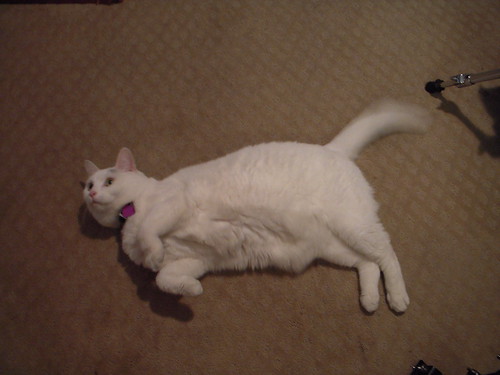
Little Gray Hat, attention hog and bat catcher, flopped down at our feet for a belly rub.
We visited him Nov. 19 at his home studio in the South Philly rowhouse he’s lived in for two years (the Washington DC native has been in Philly for 12 years!). He met us at the door, his white cat following him. The cat, Little Gray Hat, followed us everywhere in the house. She’s an old lady but clearly is loved by her owner, who told us not only was she a great mouser but she caught a bat out of the air when he was living in a warehouse in North Philly. Clearly a seminal moment in their relationship, Joe told us he made a children’s book about the cat and the bat.
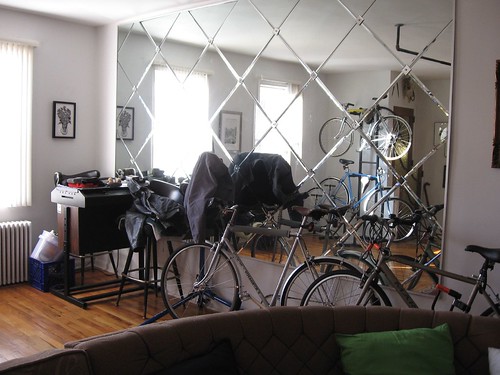
Bikes fill the living room, which still has the last owner’s mirror on the wall.
Joe’s house, which he shares with a friend, is neat as a pin and about a third of the living room is taken up with bicycles which he assembles himself; he’s a bike afficionado. He buys art and his collection includes hobo art and original works by big name artists like Keith Haring and Phillip Evergood, the latter two given to him by his late father, a psychiatrist, who collected art. His mom’s a psychiatrist too. His dad had a woodshop and when Joe was a kid he spent lots of time there making messes. He says his mom is fastidious and he’s like her.
He was an English major in college until he dropped out of school. He went to Kenyon for two years and UVA for the blink of an eye (he hated its conservatism). Now he writes quirky songs for the Nite Lights, his 6-year old band that recently played upstairs at Johnny Brenda’s.
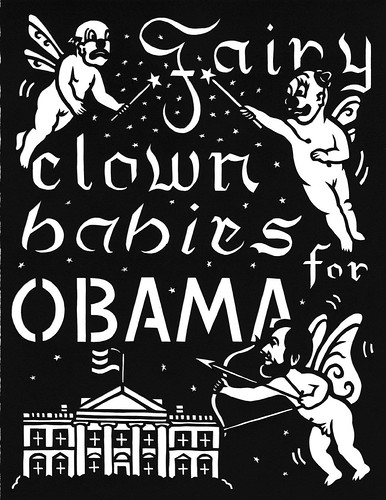
Joe Boruchow, Fairy Clown Babies for Obama. Joe papered his neighborhood with posters about McCain and Obama.
A voracious reader of classics and poetry (Melville, Cervantes, Cather, Mordechai Richler, Stevie Smith…) he is also political and sometimes makes political posters–xerox copies of his cut paper originals–and puts them up around the neighborhood.
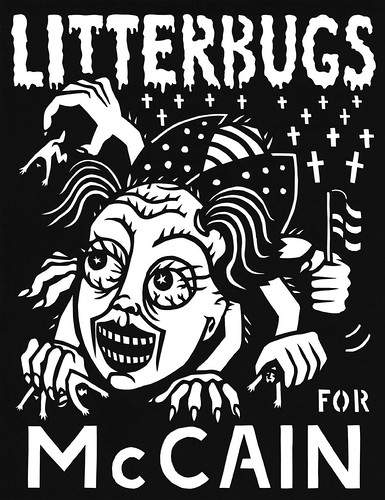
Joe Boruchow, Litterbugs. This one upset one of the neighbors.
The neighbors often don’t like them, as he found out at a recent neighborhood meeting. He said he liked that the neighborhood had more than one opinion.
Surprisingly for such an urban hipster, the artist is an outdoor type. He loves to hike and told us his last trip was to the Shenandoah Mountains. He climbed Old Rag Mountain at peak colors in the fall. “It was gorgeous. Before that, I went to Oregon, to the Rogue River Valley.”
He wanted to showed us around his house. In the kitchen we saw a copy of the latest New York Review of Books on the table, and on top of the refrigerator a painted bust of Elvis. An autographed photo of Dave the Wendy’s guy sits on the wall near the fridge.
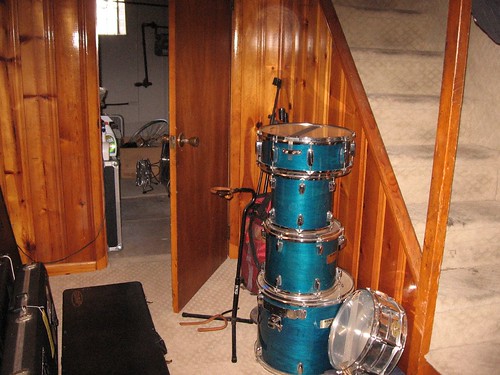
The pine-paneled basement with a stack of drums.
The pine-paneled basement is a band practice room with drum kit, amplifiers, etc, although it’s not the recording studio. Boruchow has a guitar upstairs in his art studio, which is where he writes his songs. “There’s a symbiosis between doing this and doing my song writing.” He got his first guitar when he was 12 — it was electric.
When he left school, Boruchow moved here with his sister. She has moved on to New York, but Joe stayed in Philadelphia.
artblog: You didn’t want to move to New York?
Joe: I’m not a big fan of New York. I’m going up on Saturday to Zoe Strauss‘s opening (at Silverstein Gallery). Zoe has been very encouraging to me.
artblog: How did you meet Zoe?
Joe: At the Bean Café
Bean Café and the cut paper process
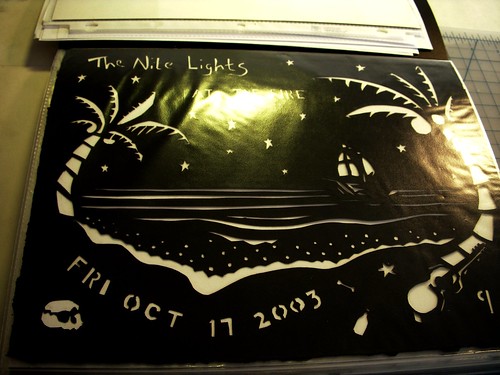
Early cut paper poster for the Nite Lights
Boruchow comes to the Bean Cafe a lot, he says, because he works nearby, at Tattooed Mom. Joe has a tattoo (we saw it peeking out of the cuff of his shirt–and we noticed another one peeking up from the back of his collar) and when he said where he worked, we assumed Tattoed Mom was a tattoo parlor and that he was a tattoo artist. He laughed and said everyone thought that but, no, Tattood Mom is a bar, and he’s a bartender there.
artblog: Do you do your cut paper at Bean Café?
Joe: I do the cut paper at the studio. It’s the only place I’m comfortable. I can’t work outside my studio. I do thumbnails on the road.
In his his studio work covers the walls hanging in grids. He’s got a bookshelf full of books, including his favorite graphic novels. We ask about his process.
artblog: How do you make these? Do you just sit down and begin to cut?
Joe: I start with drawing. Then, when I’m done cutting, I put white paper behind them and I spray them to cover the pencil marks. That’s how I get the negatives [on the white paper]. I keep them [the negatives]. They’re easier to handle as a back-up reference to the work.

A wall of negatives. Joe Boruchow’s cutout images serve as positive stencils for the negatives.
artblog: Where do you save the cutouts? They are so delicate.
Joe: I keep them in flashers. [He shows folders made of paired sheets of foam core, between which he stores the work.]
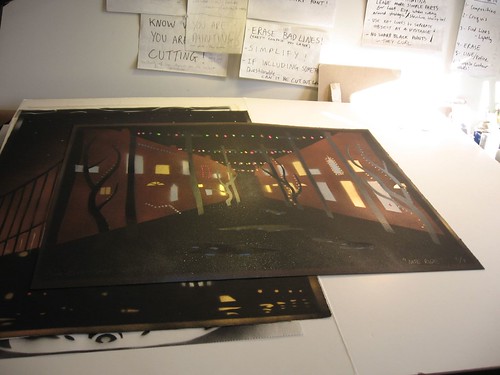
Joe Boruchow, An earlier spray-paint stencil drawing
artblog: What came before cut paper. Did you draw or paint?
Joe: I was doing spray-paint stencils. They were political. I had to make them. I’m hoping I won’t have to be making them now (that Barack Obama has won). He made stenciled posters for the Nite Lights, too.
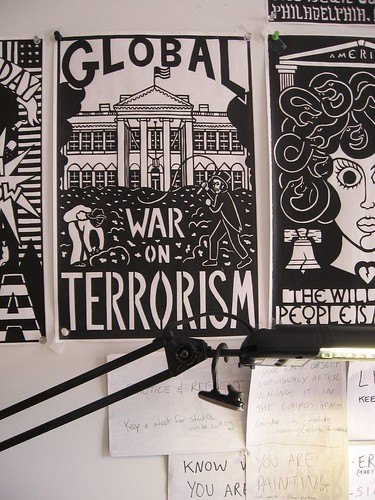
Joe Boruchow, one of his cut paper political pieces, in his studio, along with advice to himself
Then he shows us his first graphic novel, a children’s story, “The Unexpected Guest,” about Little Gray Hat catching the bat.
Joe: I completed the bulk of a graphic novel, too. It has 100 cutouts. I would love to have them in an art show.
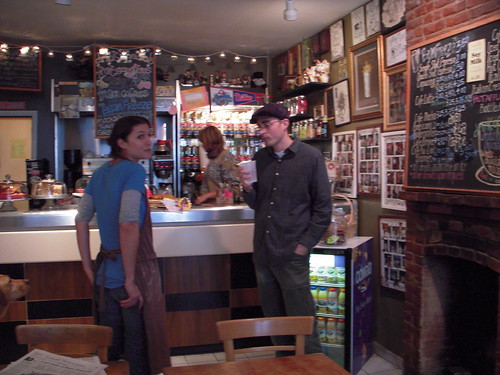
We hadn’t seen his show at the Bean so he drove us up there in his minivan–a vehicle he loves. The car has a mean streak–makes an unearthly loud noise that scared the you know out of us when the doors locked. We think Joe should make a song about the car.
artblog: How long does it take you to make a piece?
Joe: The cutting is 8 or 9 days, 4 to 6 hours/day, plus the study and the drawing. I always make a thumbnail. Just to get to the cutting takes hours. Most of my time is spent doing this.
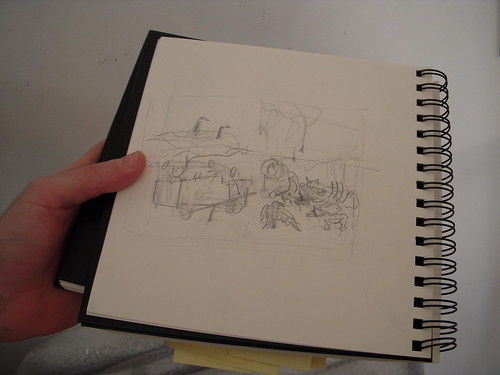
Thumbnail sketch for Abundance.
The very beginning is the worst part, looking at the paper on the wall.
I used to work from the center out. I like to look at pieces in the mirror. Randall Sellers taught me that – he was in the Bean with a mirror out, looking at his work. I take pictures (of the work). When you look at something small you can see things. I now do the parts that are the least fragile, first. I sit with the cutting board on my lap.
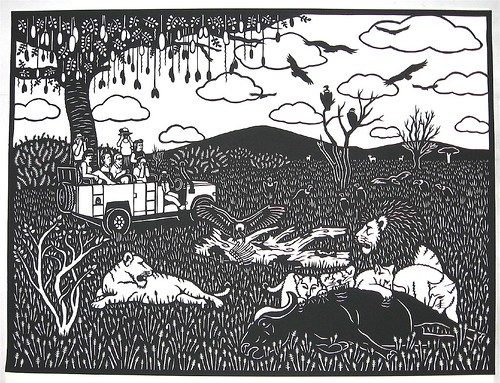
We ask about a complicated cut paper piece he calls Abundance. He was working on pieces for a show, Vanitas, at Wexler Gallery. At about the same time, he was blown away by the Turner show at the National Gallery in Washington D.C. A series of Turners called The Deluge were a turning point that led Boruchow to do a series of watery pieces for Vanitas. Some flood pieces are in his show at the Bean. We mention Kara Walker‘s exhibit, After the Deluge, about Katrina, that was at the Met.
Joe: The Vanitas show (at Wexler) was not (about) Katrina. I was bummed that Kara Walker did it and I kept waiting for someone to ask. But it was meant to be personal.
artblog: What’s next?
Joe: The book [graphic novel]; I need to redo about 20 of the pages. My style has changed over time–simplified. And the characters became more realized. It took two and a half years to do and there are major inconsistencies…
artblog, undisturbed by the inconsistencies, thought it looked great.
Art collection and influences

Joe shows us some graphic novels he admires.
In his studio and other rooms he shows us pieces he’s collected and some graphic novels by Lynd Ward, Peter Kuper, and Frans Masereel. Kuper is the only contemporary in the three.
There’s a beautiful cut paper silhouette in a frame. It’s delicate and intricate. “I think it’s by Lotte Reiniger,” he said. “She does it with scissors!!! A friend got this for me at Freeman’s.”
He also shows us the Keith Haring his father gave him–it’s not a print, but an original paint pen drawing signed “To Joe.” He met Herring once when he was with his father in New York looking at art.
Joe: That piece informs everything I do. My dad bought it for me.


